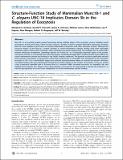Files in this item
Structure-function study of mammalian Munc18-1 and C. elegans UNC-18 implicates domain 3b in the regulation of exocytosis
Item metadata
| dc.contributor.author | Graham, Margaret E. | |
| dc.contributor.author | Prescott, Gerald R. | |
| dc.contributor.author | Johnson, James R. | |
| dc.contributor.author | Jones, Mathew | |
| dc.contributor.author | Walmesley, Alice | |
| dc.contributor.author | Haynes, Lee P. | |
| dc.contributor.author | Morgan, Alan | |
| dc.contributor.author | Burgoyne, Robert D. | |
| dc.contributor.author | Barclay, Jeff W. | |
| dc.date.accessioned | 2013-11-05T12:31:01Z | |
| dc.date.available | 2013-11-05T12:31:01Z | |
| dc.date.issued | 2011-03-21 | |
| dc.identifier | 7221119 | |
| dc.identifier | bd822e57-48a0-4804-bf2d-f86e2da55613 | |
| dc.identifier | 000288613300028 | |
| dc.identifier | 79952829229 | |
| dc.identifier.citation | Graham , M E , Prescott , G R , Johnson , J R , Jones , M , Walmesley , A , Haynes , L P , Morgan , A , Burgoyne , R D & Barclay , J W 2011 , ' Structure-function study of mammalian Munc18-1 and C. elegans UNC-18 implicates domain 3b in the regulation of exocytosis ' , PLoS One , vol. 6 , no. 3 , e17999 . https://doi.org/10.1371/journal.pone.0017999 | en |
| dc.identifier.issn | 1932-6203 | |
| dc.identifier.uri | https://hdl.handle.net/10023/4165 | |
| dc.description | This work was supported by grants from the Wellcome Trust and BBSRC. GRP was supported by a Wellcome Trust Prize Studentship. The C. elegans strain used in this work was provided by the Caenorhabditis Genetics Center, which is funded by the National Institutes of Health National Center for Research Resources (NCRR). The funders had no role in study design, data collection and analysis, decision to publish, or preparation of the manuscript. | en |
| dc.description.abstract | Munc18-1 is an essential synaptic protein functioning during multiple stages of the exocytotic process including vesicle recruitment, docking and fusion. These functions require a number of distinct syntaxin-dependent interactions; however, Munc18-1 also regulates vesicle fusion via syntaxin-independent interactions with other exocytotic proteins. Although the structural regions of the Munc18-1 protein involved in closed-conformation syntaxin binding have been thoroughly examined, regions of the protein involved in other interactions are poorly characterised. To investigate this we performed a random transposon mutagenesis, identifying domain 3b of Munc18-1 as a functionally important region of the protein. Transposon insertion in an exposed loop within this domain specifically disrupted Mint1 binding despite leaving affinity for closed conformation syntaxin and binding to the SNARE complex unaffected. The insertion mutation significantly reduced total amounts of exocytosis as measured by carbon fiber amperometry in chromaffin cells. Introduction of the equivalent mutation in UNC-18 in Caenorhabditis elegans also reduced neurotransmitter release as assessed by aldicarb sensitivity. Correlation between the two experimental methods for recording changes in the number of exocytotic events was verified using a previously identified gain of function Munc18-1 mutation E466K (increased exocytosis in chromaffin cells and aldicarb hypersensitivity of C. elegans). These data implicate a novel role for an exposed loop in domain 3b of Munc18-1 in transducing regulation of vesicle fusion independent of closed-conformation syntaxin binding. | |
| dc.format.extent | 12 | |
| dc.format.extent | 2110099 | |
| dc.language.iso | eng | |
| dc.relation.ispartof | PLoS One | en |
| dc.subject | Neuronal snare complex | en |
| dc.subject | Protein kinase C | en |
| dc.subject | Membrane fusion | en |
| dc.subject | Caenorhabditis elegans | en |
| dc.subject | Synaptic transmission | en |
| dc.subject | SEC1/MUNC18 proteins | en |
| dc.subject | Chromaffin cells | en |
| dc.subject | Vesicle docking | en |
| dc.subject | Distinct nodes | en |
| dc.subject | Binding | en |
| dc.subject | Q Science | en |
| dc.subject.lcc | Q | en |
| dc.title | Structure-function study of mammalian Munc18-1 and C. elegans UNC-18 implicates domain 3b in the regulation of exocytosis | en |
| dc.type | Journal article | en |
| dc.contributor.institution | University of St Andrews. School of Biology | en |
| dc.identifier.doi | 10.1371/journal.pone.0017999 | |
| dc.description.status | Peer reviewed | en |
This item appears in the following Collection(s)
Items in the St Andrews Research Repository are protected by copyright, with all rights reserved, unless otherwise indicated.

